The Native Forest Restoration Design
Obenaus Community, Austria
By Catherine Falardeau Marcoux
The native forest restoration project began even before Cisco Armstrong and I arrived at Obenaus, as this was one of the very purposes of Lena & Rainer’s desire to have one or two long-term volunteers. The forest on Obenaus’ land held an important place in the community since it provided firewood for heating the house and for cooking, timber for construction, resin for smudging and for making natural balm, but also it provided a sense of protection and of being warmly embraced during the winter months as the mature spruce trees danced through the wind and seemed to envelop us in a cocoon. Therefore, it was not an easy decision for the members of the community to cut down the forest.
Yet, we all agreed that this action was needed. The spruce trees had been planted in the last century, probably 40-50 years ago, in a monoculture way as it seemed to be what was economically viable to do back then with a piece of land. A few decades later and most of the trees were sick and plagued by the European Spruce Bark Beetle that is causing ravages across Europe. Indeed, because of the high demand for timber since the industrial times, European Spruce or Picea abies plantations – as well as pine plantations – have been planted in mass ever since and have unfortunately replaced many of the natural forests; thus creating monocultures prone to diseases and pests.
At Obenaus, there were already a few dead and very sick trees that were cut down the previous winter but the bug seemed to have spread since and made new victims. Before losing more of these valuable trees, Rainer and Lena thought that it would be wise to cut them down earlier rather than later. As they shared with us their concern and as we observed the state of the trees compared to the surrounding forest, we agreed with them and thought it would create an opportunity to replant a natural and diverse native forest as it once was.
Indeed, spruce trees are not native or at least not in their natural habitat in this part of southern Austria – Styria region – where deciduous beech and oak forests reign with magnificence. Spruce trees are usually found higher in altitude or in latitude. A simple gaze into the neighbouring forest patches along the creek or a walk into larger nearby forests suffices to observe the beauty and quality of the beech forests at climax (at full maturity). These forests are much more diverse and therefore more resilient than the conifer plantations (trees with needles all through the year). The native forests are composed mostly of deciduous trees that shed their leaves over the winter which help build a rich humus soil that will in turn encourage biodiversity in all the different forest layers – from the earth to the canopy tops – in addition to create a variety of micro-ecosystems and habitats for wildlife. Oak and beech trees are the main species found in these forests but one can also observe a whole range of other species.
Given the importance of such a project, it was decided that this winter (2017) would be the time to act, especially considering the time it takes to grow a forest!
During the restoration design process, Cisco and I aimed to mimic the natural regeneration of a forest. Therefore, from the list of trees offered to us by the Regional Management team, we chose species that would play different roles while striving to eventually create a healthy mixed oak and beech mature forest. Another goal was to help rebuild diversity within the forest ecosystem, so we chose as many species as we could that was appropriate for a native forest in this region. We ended up with ten different tree species. Following this section, one can find the list of all the species that were planted, their needs, the functions their serve, their different uses as well as other interesting information about them.
However, before going into more details about each species, I would like to give you a quick overview of some of the functions and characteristics we were looking for when choosing the species of trees and the locations they would be planted on the land.
Pioneer species: Pioneer tree species are species that are fast-growing and that would usually be the first ones to grow after a devastating event like a forest fire or deforestation clear-cut, etc. They are therefore somewhat resilient since they do not require a very rich or fertile soil and can grow in full sun most of the time. Yet, they are not particularly long-lived trees. But another benefit of planting pioneer species is that they quickly create shade for other tree species that are more sensitive to the sun and to dry environments. They will also help rebuild the rich humus layer required by other species to be able to grow. The pioneer species are best to be planted in most of the restoration area in order to accelerate the restoration effort.
Nitrogen-fixing species: Nitrogen-fixing tree species are another very important group to take into consideration when choosing species for restoration. Indeed, they have the extremely valuable ability to fix nitrogen from the air and make it available in the ground for other species to be able to absorb. Nitrogen is one of the major nutrients necessary for plants to grow along with potassium and phosphorus, and many others. Unfortunately, nitrogen is not naturally found in the ground as the other two nutrients, which is why these nitrogen-fixing plants play a crucial role in the biodiversity of the earth, especially in modern times where we find vast areas of land that are bare and where erosion wash away this precious nitrogen. Nitrogen-fixing plants include most legumes and other pod-like bearing plants and trees. They are good to plant across the restoration area but mostly in higher grounds or at the top of slopes – like in the case of Obenaus – to make sure the nitrogen reaches as much of the restoration land as possible instead of leaching away.
Medicinal properties*: Ancient traditions in many cultures around the world recognize the value of the multiple services gifted to us by the realm of plants, especially in terms of medicinal services. This traditional ecological knowledge (TEK) has been what allowed us to survive through thousands of years, yet nowadays this knowledge is being lost at an exceptionally fast pace. When one starts to pay attention and seek out this knowledge, it is amazing the natural abundance that one discovers is available. Plants and herbs are well-known for their numerous health properties but trees are often overlooked. However, trees also have incredible properties that offer an infinite amount of remedies and health benefits that can support one’s family over many generations.
Wildlife and pollinator attractors: Many species of deciduous forest trees – not only commercially-known fruit trees – do also bear fruits and have flowers that attracts beneficial insects and pollinators in addition to provide habitat for all kind of wildlife. Some important examples include nectar and pollen for butterfly and bees, which are both critical pollinators for the plants that grow our food. Therefore, it is a good idea to plant these species of trees that attract pollinators along the forest edge, closer to our gardens.
Added-value benefits*: In addition to the natural characteristics mentioned above, most of the tree species can provide one or more valuable by-products, such as timber, firewood, carving wood, sap for sugar, edible seeds, etc.
* For all medicinal properties and other uses mentioned in the list below, please refer to the website “Plants For A Future” for further information and proven research.
http://www.pfaf.org/user/Default.aspx
List of Selected Tree Species
The map below shows an overview of Obenaus’ land and the two main planting sites of the reforestation / restoration project. In the list and description of the selected tree species that follows, one can read the specific role that each species plays and the reasons for their location on the design. The map provides a visual reminder of the approximate location where the species were planted, but do not represent each individual tree.
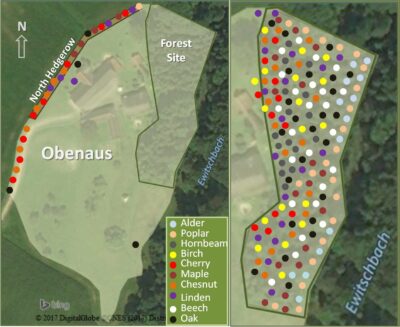
European Alder – Schwarzerle – Alnus glutinosa
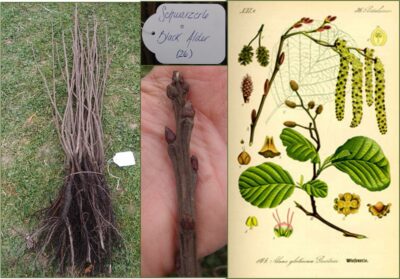
Description: Medium-size deciduous tree (~ up to 25m). Short-lived. Native to Europe. Flowers from March to April. Pollinated by wind. Seeds ripen from September to November.
Environment: Thrives in wet or very moist locations. Can grow in semi-shade or no shade, and on poor quality soils such as heavy clay. Any pH is suitable. Natural habitats include forest edges, swamps, river corridors.
Functions: Pioneer species and fast-growing. Nitrogen-fixer. Attracts wildlife (important food for caterpillars of butterfly and for small birds in winter). Pest-tolerant. Excellent source of biomass (leaf production) for building the humus layer of the forest floor. Very tolerant of coppicing which means that if branches or trees are cut back for firewood, they will re-grow easily.
Medicinal Properties: A decoction of the dried bark is used to bathe swellings and inflammations, especially of the mouth and throat. Boiling the inner bark in vinegar produces a useful wash to treat lice and a range of skin problems such as scabies and scabs. The liquid can also be used as a tooth wash. Sticks of the bark can be chewed as tooth cleaners. A decoction of the leaves is used in folk remedies for treating cancer of the breast, duodenum, oesophagus, face, pylorus, pancreas, rectum, throat, tongue, and uterus. The leaves are harvested in the summer and used fresh.
Other Uses: Underwater foundations, paper and fibreboards, joinery, turnery, carving. The wood easily splits (good for firewood) and makes a good charcoal. Different parts of the tree are used to make natural dyes. The leaves are sticky and, if spread in a room, are said to catch fleas and flies on their glutinous surface.
Role at Obenaus: This species was planted along the path at the bottom of the slope, not too far from the creek. Unfortunately, it could not be planted at the top of the slope as recommended for nitrogen-fixing trees because of its water requirements. Its nitrogen-fixing properties and fast-growth will support the other species growing nearby.
Sycamore Maple – Bergahorn – Acer pseudoplatanus
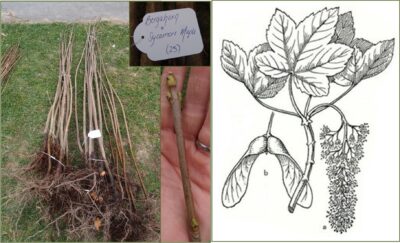
Description: Large size deciduous tree (~up to 20-35 m). Broad, rounded and dense crown. Native to Central and Eastern Europe. Flowers from April to June. Pollinated by bees. Seeds ripen from September to October.
Environment: Naturally found among birch, beech and fir forests. Needs at least partial sun, so can grow in semi-shade or no shade. Can grow well on disturbed habitats, such as roadside, hedgerows, forest plantations, semi-natural woodland. Tolerant of a variety of soil types and pH and can grow in nutritionally poor soils, but prefers moist and well-drained soils.
Functions: Pioneer species and fast-growing. Promotes phosphorous uptake from the ground. The flowers are very attractive to bees and other beneficial insects. Excellent source of food for honey bees. Good windbreak because of its tolerance to wind.
Important Information: Better to plant away from vegetable garden since the leaves can also attract aphids.
Medicinal Properties: The bark has mild astringent properties and has been used to make a wash for skin problems and an eye wash for sore eyes. The inner bark of the tree, containing the sweet sap, can be used as a dressing for wounds.
Other Uses: Timber (because it is hard-wearing and for its color, it is used for musical instruments, furniture, joinery, wood flooring; and because it is non-staining, it is used for kitchen utensils, wooden spoons, bowls, boards, etc). Good to use as fuel for firewood and it makes a good charcoal. Easy to saw and split. The sap can be tapped and drank, or used as a source of sweetener or to make wine or beer. The leaves can be wrapped around food such as buns when baking, giving them a sweet flavour.
Role at Obenaus: Planted mostly along the edges of the forest for windbreak and as pollinator attractor while ensuring access to sunlight. Its fast-growth and large crown will also provide shade for the more sensitive and slow-growing saplings in the forest.
English Oak – Stieleiche – Quercus robur
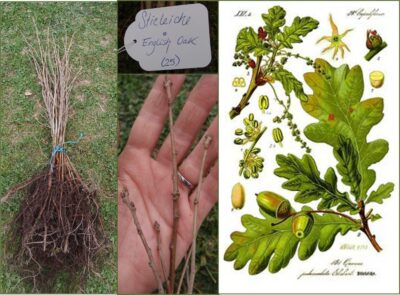
Description: Large deciduous tree (~up to 40m) with thick trunk and spreading branches, dense crown once mature. Long-lived but grow slow, so it is a late successional tree in forest regeneration. Native to Europe (from the British Isles to the Caucasus). Flowers from April to May. Pollinated by wind. Seeds ripen from September to October.
Environment: Can be tolerant to different soil conditions including clay, but prefers fertile, well-drained and moist soils. Tolerant to both alkaline and acidic soils. Can grow in semi-shade or no-shade, but some shade is better for seedlings. Tolerant to wind once well-established.
Functions: Very important tree for beneficial insects and wildlife. For example, excellent food source for caterpillars of butterfly. Climax species (long-lived tree that will compose the mature forest).
Important Information: The oak trees are probably one of the species with the slowest growth. Acorns are also only produced after 40 years so will not self-propagate until then.
Medicinal Properties: The bark is anti-inflammatory, antiseptic, astringent, decongestant, haemostatic and tonic. A decoction of the bark is useful in the treatment of chronic diarrhoea, dysentery, intermittent fevers, haemorrhages, etc. Externally, it is used to bathe wounds, skin eruptions, sweaty feet, piles, etc. It is also used as a vaginal douche for genital inflammations and discharge, and also as a wash for throat and mouth infections. The bark is harvested from branches 5 – 12 years old, and is dried for later use. Any galls produced on the tree are strongly astringent and can be used in the treatment of haemorrhages, chronic diarrhoea, dysentery, etc. It is also used in the treatment of disorders of the spleen and gall bladder.
Other Uses: The dry leaves make good mulch that repels slugs, etc. Long-lasting and durable hardwood used for interior and furniture work, and for wine barrels. Good firewood (if really necessary!). If chopped and roasted, the seed can be used as an almond substitute. The seed can be dried, ground into a powder and used as a thickening in stews or mixed with cereals for making bread. The seed contains bitter tannins; these can be leached out by thoroughly washing the seed in running water, although many minerals will be lost. It can take several days or even weeks to properly leach whole seeds, one traditional method was to wrap them in a cloth bag and place them in a stream. Leaching the powder is quicker. The roasted seed is a coffee substitute.
Role at Obenaus: Planted mostly inside the forest but also around the property. The oaks are a key species in the restoration project since the goal is to grow a native oak and beech mature forest. They will therefore grow slowly under the protection and shade of the pioneer species until it is their turn to care for the forest ecosystem and provide shelter to other species and wildlife.
Sweet Cherry – Vogelkirsche – Prunus avium
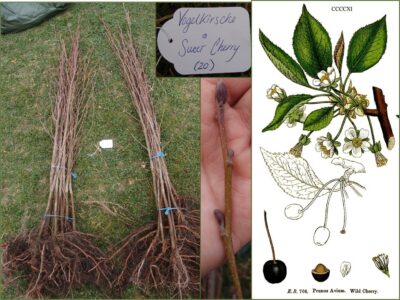
Description: Small to medium size deciduous tree (~up to 15-30m). Rounded crown. Can become quite large if left to grow wild but normally smaller. Beautiful white flowers during April and May. Pollinated by bees. Seeds ripen from July to August. Native to Europe.
Environment: Needs full sun or semi-shade and prefers well-drained to moist soils. Therefore grows better on forest edges or open lands. Any pH is suitable.
Functions: Usually fast-growing. Edible and delicious fruit. Important food source for wildlife. For example, the fruits and leaves are eaten by butterflies and the fruits by birds.
Important Information: Not to be planted near potatoes because it can make them more susceptible to potato blight. Also not a good neighbor to plum trees – will compete heavily.
Medicinal Properties: The fruit stalks are astringent, diuretic and tonic. An aromatic resin can be obtained by making small incisions in the trunk. This has been used as an inhalant in the treatment of persistent coughs.
Other Uses: Edible fruit – sweet once cooked, but can be astringent and bitter if eaten fresh. Nice wood for furniture, turnery and instruments.
Role at Obenaus: Planted as a forest edge species and on the north hedgerow to add diversity, attract butterflies and pollinators and be accessible for fruit harvest.
Silver Birch – Birke – Betula pendula
Description: Small to Medium size deciduous tree (~up to 20m). Open weeping canopy or light crown (not a dense foliage). Flowers in April. Pollinated by wind. Seeds ripen from July to August. Native to Europe.
Environment: Needs full sun. Tolerant to different pH including very acidic. Can grow in most types of soils even in nutritionally poor soil, but prefers well-drained and moist environments.
Functions: One of the major pioneer species. Very fast-growing. Important to wildlife including butterflies. Somewhat resistant to wind. Accelerate the composting fermentation process.
Important Information: Not so good as firewood since it burns very quickly.
Medicinal Properties: The bark is diuretic and laxative. The oil obtained from the inner bark is astringent and is used in the treatment of various skin afflictions, especially eczema and psoriasis, as well as treating intermittent fevers. The bark is usually obtained from trees that have been felled for timber and can be distilled at any time of the year. An infusion of the leaves is used in the treatment of gout, dropsy and rheumatism, and is recommended as a reliable solvent of kidney stones. The young leaves and leaf buds are harvested in the spring and dried for later use. A decoction of the leaves and bark is used for bathing skin eruptions.
Other Uses: This hardwood is used for furniture, kitchen utensils, plywood. The resin is an excellent waterproof glue and is useful for starting fire. The sap is also delicious. It can be drunk raw or can be cooked to become like a syrup, and can also be fermented into wine or beer. Finally, the leaves make a refreshing tea.
Role at Obenaus: Planted everywhere – inside the forest and on the edges to provide shade to slow-growing trees and to ensure their own access to sunlight. Their open canopy will also allow to see the forest behind. Some were planted near the compost station as well where the leaves will help with the fermentation process.
European Hornbeam – Hainbuche – Carpinus betulus
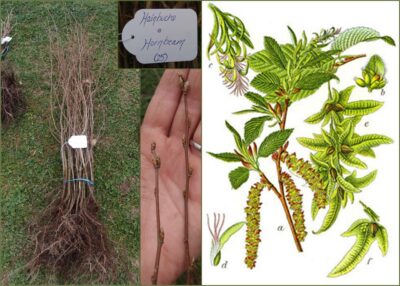
Description: Medium size deciduous tree (~up to 25m) with dense foliage. Similar to the beech tree but grows with a more crooked trunk and prominent veins. Slow to medium growth. Usually retain its dead leaves throughout the winter; therefore making a good hedgerow. Flowers from April to May. Pollinated by wind. Seeds ripen in November. Native to Europe.
Environment: Tolerant to different types of soils and pH and can even grow on very alkaline soils. Prefers moist soils. Can grow both in the shade and in the sun. Grows very well in mixed forest with oak and beech trees – in fact hornbeams can be observed in large numbers in the surrounding forests of Obenaus.
Functions: Attracts wildlife and provide food for butterflies. Pest-tolerant. Encourages natural regeneration because it self-seeds vigorously and sustains cut-backs. Its shallow but wide-spreading root system makes it a good tree to plant on slopes for erosion control.
Medicinal properties: The leaves are used as external compresses to stop bleeding and heal wounds. Distilled water made from the leaves is an effective eye lotion. The leaves are harvested in August and dried for later use. The plant is also used in “Bach flower remedies”.
http://www.bachflower.com/
Other Uses: Hard heavy wood used for tools and construction. Great firewood since it burns hot and slowly.
Role at Obenaus: Planted inside the forest to diversify the native forest once mature. Planted also on the forest edge near the house where the soil is very alkaline because of the ashes from the wood furnace which are emptied there.
European or Red Beech – Rotbuche – Fagus sylvatica
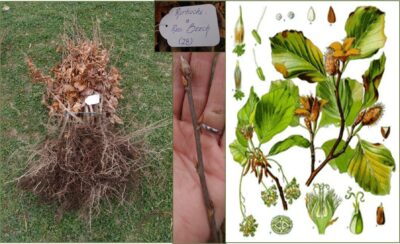
Description: Large deciduous tree (~up to 30m) with a dense canopy. Medium to slow growth. Very dense foliage. The dead leaves also usually stay clipped to the branches until the spring like the hornbeam. Flowers from April to May. Pollinated by wind. Seeds ripen from September to October. Native to Europe.
Environment: Prefers well-drained dry or moist soils, but tolerant to most types of soils. Can grow on very acidic or very alkaline soils, and in partial sun and shade. Tolerant to drought when established.
Functions: Important for wildlife and is a food source for caterpillars. Seeds are edible and delicious. Pest-tolerant. Great for erosion control because of its spreading root system. Will become a climax tree that will compose most of the mature forest (will become dominant).
Important Information: Can be slow-growing especially after transplanting. Very intolerant of coppicing – to use as firewood in moderation or only if necessary.
Medicinal Properties: The tar made by the process of dry distilling beech wood is stimulating and antiseptic. It is used internally as a stimulating expectorant in chronic bronchitis, or externally as an application in various skin diseases. The plant is also used in “Bach flower remedies”.
Other Uses: The very young leaves have a very nice mild flavor when eaten raw and are good to add to salads. The seeds can be eaten raw or cooked and have a pleasant sweet taste. They can also be dried and ground into a powder and used with cereal flours when baking, but should not be eaten in large quantities. The roasted seed is used as a coffee substitute. A semi-dry oil is obtained from the seed, it is used as a fuel for lighting, as a lubricant, for polishing wood, etc. The leaves can be gathered in autumn and used as a stuffing material for mattresses, etc. The wood is very durable and used for furniture, flooring, etc, but is not recommended to be used for outside purposes. Great firewood that burns with a lot of heat and makes a popular charcoal.
Role at Obenaus: The red beech is another key species in the restoration project as it is one of the two species along with the oak that will hopefully dominate the native mature forest. It was therefore planted across the restoration area on the inside of the forest.
European Aspen or Poplar – Pappel – Populus tremula
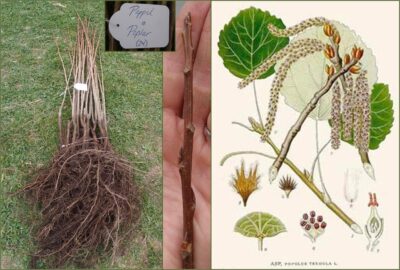
Description: Medium to large deciduous tree (depending on the variety of the species). Short-lived. Suckers grow easily and thus can form dense thickets at the base of the tree. Flowers from February to March. Pollinated by wind. Seeds ripen from May to June. Native to Europe.
Environment: Preferred environments are open woodlands or hedgerows. Grows in full sun to partial shade. Can grow on poorer soils and heavy clay soils, but not so much on alkaline soils. Prefers moist or wet soils. Tolerates strong winds and thus make a good shelterbelt.
Functions: Pioneer species and very fast-growing. Windbreak. Great for wildlife and butterflies. Resistant to browsing by deer due to unpleasant taste. Can improve heavy clay soils.
Important Information: Do not self-propagate easily, so no risks to spread around. Important not to plant near drainage system as the roots are very extensive and aggressive.
Medicinal Properties: The bark is anodyne, anti-inflammatory and febrifuge. It is used especially in treating rheumatism and fevers, and also to relieve the pain of menstrual cramps. The plant is also used in “Bach flower remedies”.
Other Uses: The timber makes a high quality paper and a very good charcoal. The wood is easily split.
Role at Obenaus: Planted around the forest area on the edges as windbreak and to create a natural protection against deer browsing. Because it is fast-growing and tall, it will also provide shelter to the more sensitive trees inside the forest.
Sweet Chesnut – Edelkastanie – Castanea sativa
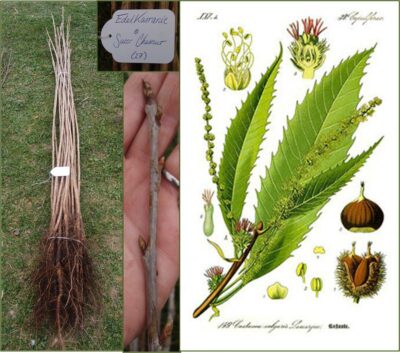
Description: Medium to large deciduous tree (~up to 30m). Medium growth. Long-lived if not cut down. Flowers in July and pollinated by bees. Seeds ripen in October. Native to the Mediterranean in south-eastern Europe but naturalized throughout southern Europe.
Environment: Can grow on very acidic and neutral pH soils, but not very alkaline. Prefers well-drained soils but can grow on poor soils too. Very drought tolerant. Needs at least partial sun, cannot grow in full shade.
Functions: Attracts wildlife and pollinators, including bees. Enrich acidic soils. Edible and delicious seeds.
Important Information: The trees can re-grow very quickly after being cut down, which can produce usable timber every ten years or so.
Medicinal properties: Sweet chestnut leaves and bark are a good source of tannins and these have an astringent action useful in the treatment of bleeding, diarrhoea, etc. The leaves and bark are anti-inflammatory, astringent, expectorant and tonic. They are harvested in June or July and can be used fresh or dried. An infusion has been used in the treatment of fevers and ague, but is mainly employed for their efficacy in treating convulsive coughs such as whooping cough and in other irritable conditions of the respiratory system. The leaves can also be used in the treatment of rheumatism, to ease lower back pains and to relieve stiff muscles and joints. A decoction is a useful gargle for treating sore throats. The plant is also used in “Bach flower remedies”.
Other Uses: The seeds have an astringent taste when eaten raw, but are sweet when cooked or roasted. The seed is rich in carbohydrates; it can be dried, then ground and used as flour in breads, puddings and as a thickener in soups. The roasted seed can also be used as a coffee substitute. The meal of the seed has been used as a source of starch and also for whitening linen cloth. A hair shampoo is made from the leaves and the skins of the fruits. It imparts a golden gleam to the hair. The timber is resistant to outdoor use, thus perfect for posts, fencing or stakes. Great wood for furniture, roof beams and barrels to age vinegar. The wood makes a good fuel.
Role at Obenaus: Planted inside the forest for enriching the soil of the old spruce forest and make it less acidic. Planted also on the forest edges for attracting pollinators and to harvest more easily the seeds. Planted mostly near the top of the slope since it is very drought tolerant.
Basswood or European Linden – Linde – Tilia cordata
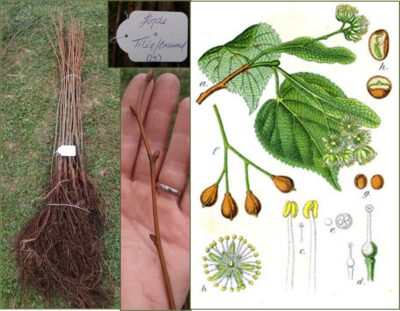
Description: Large deciduous tree (~up to 30m). Medium growth. Dense foliage. Flowers from June to July. Pollinated by bees. Seeds ripen in October. Native to Europe.
Environment: Prefers moist and well-drained soils, but can grow in most types of soil. Any pH is good, but prefers alkaline soils. Grows in semi-shade or sun. Can tolerate strong winds.
Functions: Attracts wildlife. Very valuable tree for bees, producing an abundance of nectar. A favorite for teas.
Important Information: Can be easily transplanted even when older. Can produce many suckers at the base of the tree, therefore it is best grown in woodland. This tree is becoming increasingly rare and is an indicator of ancient woodlands. It is also recognized as holy or sacred in some cultures.
Medicinal Properties: The flowers make a popular herb tea that has a sweet and fragrant flavor and have many medicinal properties, including for the treatment of colds and other ailments where sweating is desirable. The tea is also used internally in the treatment of indigestion, hypertension, hardening of the arteries, hysteria, nervous vomiting or palpitation. Linden flowers are said to develop narcotic properties as they age and so they should only be harvested when freshly opened. A charcoal made from the wood is used in the treatment of gastric or dyspeptic disturbances and is also made into a powder then applied to burns or sore places.
Other Uses: The young leaves can be eaten raw, in salad, etc. The sap, harvested in the spring, is sweet and can be used as a drink or concentrated into a syrup. A very nice chocolate substitute can be made from a paste of the ground-up flowers and immature fruits. Good wood for carving domestic items. A charcoal made from the wood is used for drawing.
Role at Obenaus: Considered a sacred tree, Tilia cordata was therefore planted across the restoration site (inside the forest and on the edges) as well as around the property, meeting its needs for sunlight and attracting bees to the garden areas.
Planting Days
Dates: ~ March 30th to April 9th 2017
Planting Site: Approximately one acre of forest and one hedgerow on the north side of Obenaus land, as shown on the map of the previous section.
Number of Trees Planted: 250 (25 x 10 species)
The implementation process of the reforestation / restoration project was completed rather efficiently and professionally given the numbers of trees that needed to be planted and the circumstances. Indeed, despite having received only very short notice from the Regional Management team for the pick-up date, we managed to establish a temporary nursery for the young bare-root saplings to be planted right away upon their arrival on the site. This step was very important in order for the roots to stay moist and covered (in the soil) until they would be planted in their permanent locations.
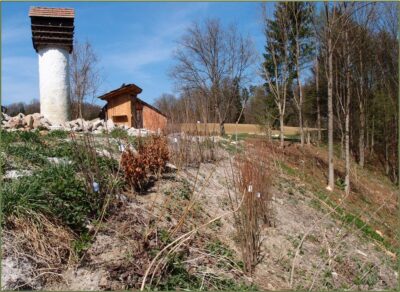
Moreover, since this sale was an offer for the farmers of the region, one had to buy per bundle. One bundle of each species of trees contained 25 individuals. Therefore, we bought and planted 250 trees in total, with the exception of a few gifts.
As for the team members that participated in the planting days, quite a few people of the immediate community as well as the greater community got involved and gave the time and effort they felt they could contribute. This was very helpful given that Cisco was away during this time. Therefore, I would like to offer my gratitude to Lena, Rainer, Chris, Sam, Youssef, Jeanne-Sophie, Jacob, Nico and Tamino – some of whom are present in the picture below enjoying well-deserved baked goods and a cup of tea!
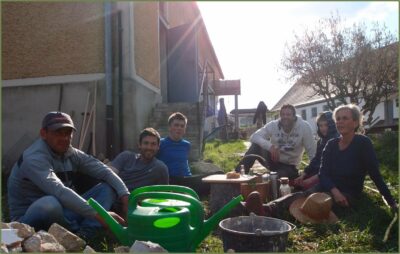
I would like to say a special thank you to Martin as well; first of all for cutting down the forest. This was quite a task in itself as one can see in the pictures below, and required the full participation of some of us – including our good friends Jasmin and Nico – for nearly a week back in January. Thank you as well Martin for cutting all the 250 and more stakes for the new trees, and for the useful knowledge you shared with me all along.
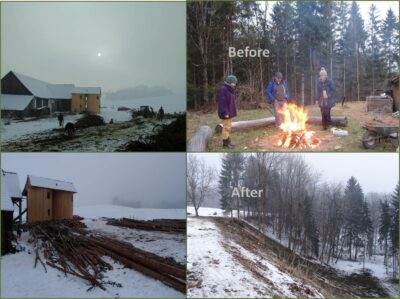
In order to be efficient while still ensuring a quality planting, I attributed different tasks to our helpers. First, one would go and place the stakes where trees would be planted across the restoration site keeping at least five meters in between. Although this may seem close for big forest trees, a high density planting is preferred when restoring a forest – compared to planting an orchard – since different tree species will grow at different rates and will require different conditions thus supporting each other in their growth. Also, a high density planting mimics the natural regeneration of a forest as well as encouraging the trees to be resilient.
Then, a team of two would go and do the most physically demanding job which is to dig the holes for the trees where the stakes were. Not only is digging demanding to begin with but doing it in a very steep slope amongst roots and rocks is another challenge altogether. That slowed down the digging process, which was in fact a good thing because it allowed digging only the holes the day of or the day before a tree would be planted in it – ensuring a moist soil. The holes did not need to be very deep and large like usually required when planting trees in an orchard or in a backyard. In the forest, the soil is already quite good, fluffy and loose (not so compacted) – giving the space for the roots to grow and water to flow without drainage issues.
Next task would be done by me most of the time which was to bring the saplings to their respective holes for the next team to plant them. Following our restoration design, I placed each species of trees at the locations that suited their requirements and where they would provide the function or service expected from them.
The saplings would then be carefully planted by another team. We first hammered the stakes properly into the ground. Then, we made sure to give the roots enough space, and filled the holes with the loose top soil that was dug out. Each tree was loosely attached to their stake in a way that allows enough space for the trunk to get larger while still serving the purpose to hold the tree against the wind and to help the tree grow straight and strong. The ground surface around the trees would be covered with some organic material like dry leaves, small sticks, etc, to act as mulch and to keep the soil moist. We also tried to create a little mini-dam at the front of each tree with small strong sticks staked vertically and others placed horizontally behind with some rocks, in order to prevent erosion and to retain as much water as possible.
Another team of one or two people would follow the planters and water around the trees. This task would have also been done before the planting – so watering just the holes first – but given the topography, it did not make sense to do that. Indeed, the watering hose would only get so far as the top of the slope and the rest of the trees needed to be watered with a watering can with water gathered from the creek down below.
Finally, a small rabbit-proof cylindrical fence was placed around most of the trees, especially the oaks, maples, and other favorites of wildlife. These protective guards should deter rabbits and other rodents to eat the bark at the base of the young trees. This action called “girdling” can be very damaging to young saplings and eventually kill the trees. Although, the mesh fences used are not high enough to also protect against deer nibbling on the terminal buds of the saplings, it might reduce the damages by limiting the access.
After the planting effort, the trees were monitored and watered occasionally in the weeks and months that followed, until the summer growth became too wild for the task. Indeed, nettles and elderberry bushes, amongst many other fast-growing and opportunistic plants, took over the freshly cut area of the forest during the summer months.
Recommendations
Often during a reforestation or restoration effort, the focus is placed on the planting action. Yet the maintenance or after-care of the trees is as important as planting them in order to reach the long-term goal of forest regeneration and ecosystem improvement. Fortunately, caring for forest trees is not usually as demanding as caring for fruit trees. One visit of the site per season should be enough to provide for sufficient care during the first few years following the planting, with the most important visits being in the fall and spring.
This fall, at Obenaus, when the overgrowth of vegetation begins to die back and one can more easily access the forest site, it will be important – especially for a first visit – to go to each tree and perform the following (the stakes should help to find the trees that were planted). It could also be a good idea to write down some observations.
Verify and observe the condition of the tree and make the necessary adjustments:
– Does it seem to have survived the summer heat and competition? If so, great! If it looks like maybe not, I suggest writing down the location and give extra-care to these trees during the next few visits. Maybe it will only starts to grow the following year and only needed time to adapt and transition. However, a certain percentage of mortality is to be expected and can be caused by several factors. In the second year, dead trees can be replaced by new saplings. Then, extra care can be given to plant these new neighbours in the best micro-climates / locations around and give them extra love.
– With sharp pruners (or garden scissors), prune (or cut) any broken branches as close to the trunk as possible to allow for potential re-growth. Never rip the branches with your hands. It is also best to make the cut on an angle. After the tree is well-established, so maybe around the second or third year, it is recommended to also prune the leaders or “suckers” – branches that grow from the base of the trunk – in order to encourage the growth energy to focus on the main stem and upper branches. Yet, this is not so necessary in a forest ecosystem.
– Does the tree seem to still be firmly held into the ground? Make sure it is by re-positioning it gently (without uprooting it), adding more soil if needed and attaching it better to the stake. Staking should only be necessary during the first 2-3 years maximum until the tree seems strong enough to hold itself against the elements. Staking a tree too long can result in reducing the resiliency of that tree and damaging the trunk.
– With a sharp machete or knife or large garden scissors, cut back some of the competing vegetation around, especially at the base of the tree, and if possible pull the roots of these plants out as well. By breaking down some of that vegetation and turning the roots upside down, all of this organic material can be used as mulch to cover the surface of the soil around the tree and retain moisture. One can also add more dry leaves and other surrounding natural material to provide for a good thick mulch layer. It is important however that the mulch do not touch the base of the tree, at least not with a thick layer to avoid rotting or the spread of disease.
– It would be good to also observe the erosion that occurred around the tree given the steep slope of the site. One can adjust or re-build a more resilient little dam in the front of the tree using sticks and stones. One can also add small tree trunks or other bigger pieces at the front of it to help retain water and soil.
– Are the rabbit-proof fences overgrown by vegetation and are they still serving their purposes? Most likely it will be necessary to clear the vegetation off them and adjust or lift the fences as needed to best protect the tree – as the winter coming up is the season when girdling most occur. After a snowfall, it can also be a good idea to observe evidence of rabbit circulation, like their pea-shape droppings, on the restoration site, which can help to identify their favorite trees and locations that can then be better protected.
– Make notes of any observation that can look like signs of pest or disease, and research the proper follow-up required.
– Watering the trees should not be necessary given that they are growing in a forest ecosystem with a rich soil that has a good composition and enough organic material to retain the necessary moisture that they need. Yet, extra water would definitely be beneficial given the slope, and so during the spring, summer and fall visits – the annual growing season – it is recommended to water the surrounding base of the trees with a watering can that has a sprinkler top or the mist option of the garden hose in order not to wash away the top soil.
